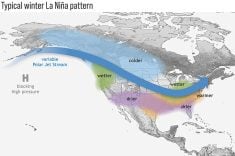VANCOUVER – Ten years after the provinces began to seriously discuss the dismantling of provincial barriers, the walls may finally begin to come down in 1995.
Arthur Mauro, chair of Internal Trade Negotiations, discussed the 195 pages of work done so far in allowing free movement of Canadian goods, services, people and capital.
Mauro told the Canada Grains Council annual meeting that he is still confident that the document will be completed and go into effect June 30, 1995.
Trade barriers among provinces have frustrated businesses and commodity groups. As far back as 1940, there was talk of the need for an open and efficient internal Canadian market, and a competitive economy, Mauro said.
Read Also

Canadian Food Inspection Agency extends chronic wasting disease control program consultation deadline
Date extended for consultation period of changes to CWD program
In 1985, a royal commission found it was easier for producers to sell in another country than in another province. Mauro noted the irony that 125 countries signed last week the General Agreement on Tariffs and Trade but “in this country we’re still talking if we should have free trade.”
Various barriers
Three kinds of barriers exist – laws and regulations, practices that differ from province to province such as food inspection, and policies such as subsidies that give unfair advantage to a certain region or province.
“We Canadians are our own best customer,” Mauro said, quoting 1989 figures of $146 billion worth of trade within Canada. Provinces and territories sold 40 percent of their goods to other provinces. Most of the trade was in food and grains, equalling $11 billion.
Mauro estimated it costs at least one percent of the gross domestic product – about $1,000 a year for a family of four – to keep the barriers.
The barriers remain because the government can introduce policies at any given time, discriminate against other provinces, and there’s no basis for co-operation. This leads to duplication, overlap and inconsistency – and no mechanism to resolve it.
In 1985, the provinces tried dealing with the problems issue by issue. This didn’t work so now the provinces are working toward an agreement on a clear set of rules.
Policies for free movement
Mauro said the three guiding principles include: governments will treat goods, services, people and capital equally; standards and regulations will be the same; and the provinces will ensure policies provide free movement.
The issues of transition periods, environmental concerns, and consumer standards are all still to be resolved. Even with an agreement problems will still remain, said Mauro: “A number of issues are never to be resolved.”
The agreement will also provide a dispute settlement mechanism that involves consultation and resolution among parties. The mechanism will not be “complex, costly or burdensome,” Mauro said.
On the question of non-compliance, Mauro said he’s against retaliation or withdrawal of benefits.
As for progress of the document he’s working on, Mauro said the provinces have made headway on labor mobility, but supply management still remains a sensitive issue.
“Certain provinces feel particularly, extremely strongly about the whole question of supply management; other provinces are saying everything is on the table.”
Another issue is beer sales, where “they’re not accepting loss of revenue with good grace.”














